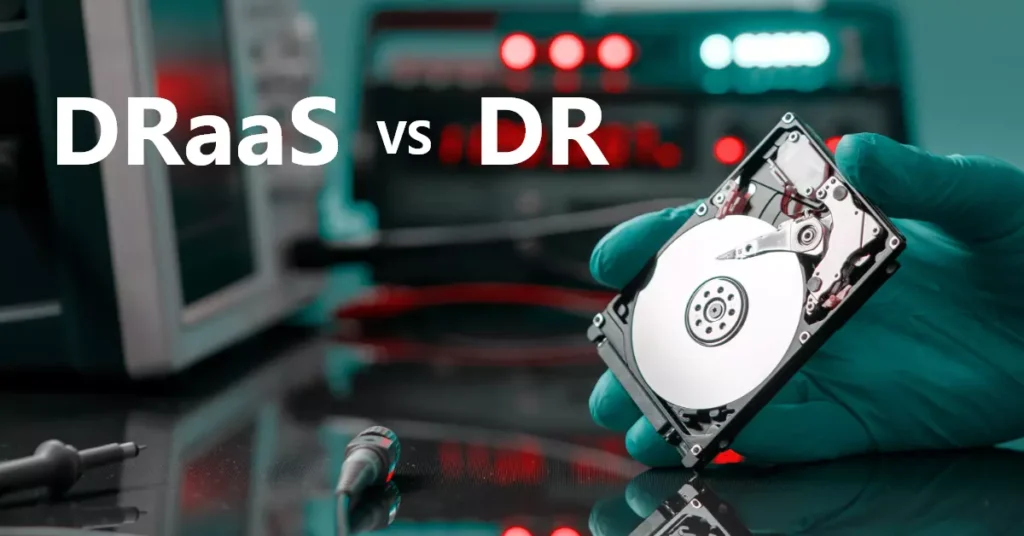What is DRaaS (Disaster Recovery as a Service)?

Disaster Recovery as a Service, or DRaaS, is rapidly becoming popular, and many providers are offering this service. You may also have heard about it, but you need to know what DRaaS is and how it is helpful for your business. Do not worry; you can get all the information about it in this article.
It is no secret that all businesses today rely on internet connection and data to function more than ever before. Suppose your employees cannot access your network, data, or applications.
In that case, it may lead to numerous problems, such as your customers needing to be served, missed opportunities, and not finalized sales. In other words, your business may not meet its potential, and in the worst cases, you may go bankrupt.
The discovery of cloud-based Disaster Recovery as a Service (DRaaS) solutions makes it far easier for organizations to protect themselves.
Stay with us till the end to know more about this service and understand how it can be beneficial for your business.
What is Disaster Recovery as a Service (DRaaS)?
DRaaS is also known as business continuity-as-a-service (BCaaS). It is a cloud computing service designed to provide remotely hosted backup and disaster recovery services.
With these cloud-based services, organizations do not need to have their outside servers and also do not need to worry about managing disaster recovery after a disaster or a cyber attack.
Your DRaaS provider is responsible for the entire recovery process so that you can focus on more important parts of your business instead of spending time on the backup and running.
No matter your business’s size, DRaaS has become a must-have solution to protect your critical data, applications, and network infrastructure in increasingly virtualized, distributed, and mobile data.
How does Disaster Recovery work As A Service?
Disaster recovery as a service reduces the pain for businesses as a crisis or disaster strikes. With the help of vendor relationships, DRaaS providers can host data, server information, and files on their own devices or in the cloud.
It means that any disaster that might happen to a local device, like fire or flood, would not impact the information that is stored on your DRaaS provider. And after the disaster, your service provider uses their specialized expertise to manage their recovery efforts.
Types Of DRaaS (Disaster Recovery as a Service)

Before choosing a cloud-based disaster recovery service provider for your business, you need to consider three major types of DRaaS offered by most service providers. Though there are only minor differences in these three models, DRaaS providers usually fall into these three categories.
1. Self-service DRaaS
A self-service provides businesses with the tools and resources required to perform their own recovery planning and DR backups. It is the least expensive alternative to conventional DR, which ensures that they can manage their end-to-end disaster recovery process.
With such a system, your IT team is entirely responsible for carrying out disaster recovery if any disruption occurs.
Self-service DRaaS is ideal for companies with in-house DR experts and IT bandwidth to control the recovery process.
2. Assisted DRaaS
In an assisted DRaaS solution, the service provider serves as an adviser to introduce, manage and evaluate the ideas in the supported model.
Vendors can handle the weakest areas of DR expertise and let you be in charge of all facets of your company’s DR process, from testing, integration, and validation.
The DRaaS provider can provide additional support to assist with failovers if any disruption occurs.
3. Managed DRaaS
A managed DRaaS system ensures that the service provider is in charge of everything, such as planning, testing, and managing disaster recovery strategy.
With such a service, your service provider will handle all the facets of DR, reducing the burden on your IT teams and letting them concentrate on other business priorities.
In case of any disruption, a managed DRaaS provider handles the disaster recovery with platform-agnostic technology. It is the most expensive option among all the types of DRaaS models.
Benefits Of DRaaS For Your Business

When disaster strikes, it can take businesses offline for days or weeks. When companies are offline, they miss out on valuable sales, lose their customers’ trust, and cannot respond to customer issues.
DRaaS can help your business avoid downtime when disaster strikes. You can understand the importance of DRaaS service by looking at its benefits. Here we are describing some most significant benefits of having DRaaS:
Reduce the Cost Of Downtime
Businesses with a second site for disaster recovery are familiar with the expenses associated with it. Along with unavoidable investments in replication software and license for servers, security and storage are significant additional costs.
The cost of downtime always hurts, regardless of the size of your business. The losses of downtime can be highly shocking. For example, a recent 6 hours Facebook outage resulted in almost $100 million in lost revenue. It may not be possible for companies to prevent all the attacks on their systems, but they can control the safeties they put into place to restore operations adequately.
You can eliminate most of the additional costs by using DRaaS through a well-reputed and managed service provider. With the help of DRaaS, you can reduce the following expenses:
- Owning a space for a secondary data center.
- Monthly costs are related to the secondary site’s power, cooling, and internet bandwidth.
- Travel to and from one data center to another or the cost of staff at the secondary data center.
- Costs of purchasing or leasing servers, storage, and network equipment for secondary sites.
Lower Complexity
As we described above, building and maintaining a secondary data center can be expensive and complex. With Disaster Recovery as a Service (DRaaS), you can eliminate all infrastructure-related complexities.
Furthermore, administration, maintenance contracts, and upgrade requirements can also be eliminated.
Reduce the Burden On the IT Team
Developing and managing disaster recovery plans is daunting and expensive. The same may be true for establishing and testing recovery and backup operations. When you have disaster recovery services, your IT team can save time managing a secondary site or data center and focus on important things.
You can also minimize maintenance costs by removing all the hardware and gaining access to the dashboard and tools offered by DRaaS.
DRaaS can be deployed in a short time compared to building a secondary disaster recovery site which can take weeks or months. It helps reduce complexity and simplify the DR solution with a single provider, saving businesses and IT teams time.
Increased Security
Your data is backed up in a safe manner and stored in a faraway data center when you have DRaaS. It protects your data from unwanted exposure and unexpected problems.
Currently, all cloud-based service providers use advanced encryption, dependable security mechanisms, and regular security updates to keep all their client’s data secure.
You may need help to attain that degree of security on local premises. DRaaS helps you protect all your data and servers within a reasonable budget and time frame.
Easily Scale Up
Scalability is one of the most significant benefits of cloud services as compared to conventional on-premises systems.
If your business grows and you want to expand your firm, you also need to expand your disaster recovery system. For several reasons, it can be extremely challenging with an on-premise disaster recovery solution.
You need a physical space for a startup to create a non-cloud-based DR setup. In addition, the cost of the required equipment for scaling up will be high.
On the other hand, with a DRaaS, you can assess your requirements anytime and upgrade your system as needed. It is a cloud-based service that allows you to protect as many databases, sites, VMs, and locations as you want at an affordable cost.
Faster Recovery Time
The longer it takes to recover from a disruption, the more revenue your company will lose.
Traditional DR solutions take a long time to recover, but a cloud-based recovery solution usually gets your system up and running within 15 minutes or even fewer.
Companies can also choose how they want their mission-critical systems to be protected and alter their required recovery scope depending on their needs.
Difference Between DRaaS And DR

In a traditional disaster recovery (DR) system, a secondary data center hosts physical IT infrastructure. This DR solution regularly replicates all the critical information and data from the primary site to a secondary site. This replicated data at the secondary site remains dormant until a failover trigger restores it for use.
- The secondary site is always far from the primary site so that both data centers are not affected by the same conditions or disasters. If you are using a legacy DR, your IT team must have relevant skills to support testing and recovery.
- On the other hand, DRaaS is a cloud-based disaster recovery solution designed to allow businesses to host their replication site on the cloud. It is a virtualized DR solution that can be used in conjunction with a physical environment and can be converted rapidly into a primary production site in case of any disruption.
- One of the major differences between DRaaS and traditional DR is that DRaaS does not need any dedicated secondary data center. The virtualized disaster recovery systems store data of a number of customers in their own data centers. It means businesses can save upfront hardware costs as they do not need to purchase a secondary site server and location.
In addition, DRaaS is easy to deploy and maintain, which makes it easy to test and recover. Companies only have to pay for storage while replication of data occurs at the secondary site.
Although this secondary site is always dormant, businesses must pay for CPU resources and memory when a failover is triggered.
Final Words
Both natural and man-made disruption can not only cost your company but also lead to its closure. That is why an efficient disaster recovery system is essential for a business. Disaster Recovery as a Service can be the best option to keep your data safe on a cloud-based system. Choosing the right service provider can be a laborious process. You must remember a few things when choosing a DRaaS solution, such as the failover capacity you need and whether you need real-time replication. The most important thing you must consider while choosing a DRaaS solution is the cost you must pay in case your DRaaS environment needs to go into production. You must ask such questions from different providers and make a price comparison before making a final decision.
Read More : What is Leased Line? A Comprehensive Guide
Read More : Leased Line Advantages And Disadvantages | Wan.io



